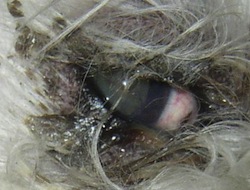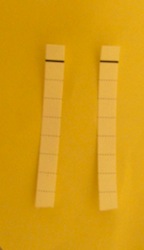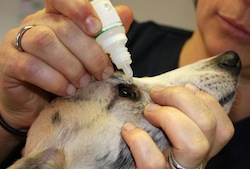The keratoconjunctivitis Sicca
 The lacrimal glands, throughout the day, tears which will form a natural protection for the eye : the tear film.
The lacrimal glands, throughout the day, tears which will form a natural protection for the eye : the tear film.
A lack of secretion of those tears will have a dry eye itself responsible for inflammation of the conjunctiva and cornea. This condition is called : Keratoconjunctivitis Sicca.
What are tears ?
The tear film provides several functions :
– a role of protection : the permanent humidification of the cornea provides mechanical protection against all types of attacks (wind, dust…)
– a role of nutrition : tears are the cornea nutrients and oxygen it needs
– one antibacterial action
– a role of cleaning : small foreign particles are trapped in the mucus and eliminated through this
– one helps the sliding of the eyelids on the cornea
When lack of secretion of tears, These functions are more assured and various symptoms appear.
What are the symptoms associated with keratoconjunctivitis dry ?
Several symptoms of keratoconjunctivitis Sicca suffering dog :
– The eye reached is Red. Signs of "discomfort", from pain are noted (the animal blinks regularly eyelids, He frequently rubs the eye with the paw)
– Of flows mucus (or even pus when an infection is present) stick to the eyelids and give it a look dirty permanently
– The eye loses its smooth and brilliant
– The cornea loses its transparency : whitish spots appear first by location then an '' opaque film '' comes gradually cover the quasi-totality of the cornea
– Of small vessels develop on the surface of the eye
– Advanced stages, the dull and irregular cornea is covered with brown spots, This pigmentation increasing with time
– Finally, of ulcers corneal may widen
Origin of keratoconjunctivitis dry
Some breeds are predisposed such as the poodle, Cocker, West Highland White Terrier as well as many brachycephalics breeds (dogs with short snouts) including the Shi Tzu, Pekingese, Cavalier King Charles, Lhasa Apso, Bull Dog…
Several causes can be originally:
– Immune : It is the most common cause of keratoconjunctivitis dry.
The immune defense of the eye system tackles by mistake to the lacrimal glands. The associated inflammation causes their gradual destruction and thus the decrease in secretion of tears
– Aging : the lacrimal glands gradually escalate over time
– Abnormal development : the lacrimal glands are not normally formed during development of the embryo, a lacrimal gland can, for example, be absent at birth
– Endocrine imbalance : including diabetes or Cushing's Syndrome
– General disease : Distemper, Leishmaniasis…
– Drug : For example during administration of anti-epileptic or prescription extended by some antibiotics of sulfonamides
In all these cases, the pathology is frequently bilateral
In other cases of keratoconjunctivitis dry, only one eye is reached, especially when the origin of the condition is :
– Neurological : When paralysis of certain nerves of the face (other symptoms are also present)
– traumatic : the trauma causes significant inflammation of the conjunctiva, itself responsible for a partial destruction of the lacrimal glands
Diagnosis
 To highlight a keratoconjunctivitis Sicca, your veterinarian is going
To highlight a keratoconjunctivitis Sicca, your veterinarian is going
perform a test called"schirmer test”:
a small flexible absorbent Strip will be placed between the eye and the eyelid of the animal during 1 minute and collect tears secreted in this time.
The amount of tears produced in one minute can then be assessed and compared to established standards (15 20 mm/min in dogs and 10 at 15 mm/min in the cat)
A careful review of both eyes will then search for any secondary lesions as :
– pigmentation or the presence of small vessels on the surface of the cornea
– the presence of corneal ulcers revealed by one fluorescein test :
This colorful product attaches on injured areas of the cornea, to highlight the presence of possible ulcers.
Treatment
 Your veterinarian will look for, during the consultation, a condition or a specific cause that can explain the presence of keratoconjunctivitis dry. Thus, If a drug can be implicated, It will be, to the extent possible, order. Similarly, If other symptoms are associated with keratitis, a general disease will be considered and its therapy.
Your veterinarian will look for, during the consultation, a condition or a specific cause that can explain the presence of keratoconjunctivitis dry. Thus, If a drug can be implicated, It will be, to the extent possible, order. Similarly, If other symptoms are associated with keratitis, a general disease will be considered and its therapy.
Treatment can then be put in place.
It is based on :
The application, morning and evening, from Ophthalmic ointments lacrymogeniques at base of Cyclosporine
– This molecule halts the autoimmune destruction process of the lacrimal glands (so it is especially useful for keratoconjunctivitis Sicca secondary to immune disorder)
– It stimulates the secretion of tears
– It limits inflammation
– to combat secondary infections
Instillation, several times per day, from substitutes for tears who will play the role of tears naturally secreted by the lacrimal glands
For best results, These ointments and lacrimal gels should be administered at a minimum interval time from the other.
Your veterinarian will assess the effectiveness of the treatment by the realization of a new shirmer test :
– If the secretion of tears is still very low, the lacrimal glands are destroyed; only the treatment with substitutes of tears will be maintained.
– If the result of the schirmer test is much improved, the cyclosporine treatment is continued. Discontinuation of administration of ointment is generally accompanied by a new tear deficiency and this treatment should therefore, most often, be maintained for life.
Of antibiotic and anti-inflammatory eye drops are associated with the SALVES of cyclosporine and lacrimal gels to treat secondary lesions (bacterial superinfection, neovascularization to the surface of the cornea…)
Finally, one surgery is sometimes necessary :
– During deep ulcer, the eye will be closed temporarily to facilitate the healing of the cornea
– When pigmentation resulting in significant Visual discomfort, the pigmented zones can be removed surgically
– When refractory dry keratoconjonctivites to any medical treatment, a salivary canal may be, in some cases, be deflected in order to refer to the level of the eye and thus ensure humidification of the cornea
§
An untreated keratoconjunctivitis Sicca has many repercussions: chronic pain, Infectious conjunctivitis to repeat, loss of transparency and pigmentation of the cornea resulting in a decrease in vision, corneal inflammation that may cause ulcers or even perforation of the cornea…
Do not hesitate to consult your vet facing any meaningful signs of this condition (Red eye, painful, dirty, dull, Pigmented…)

